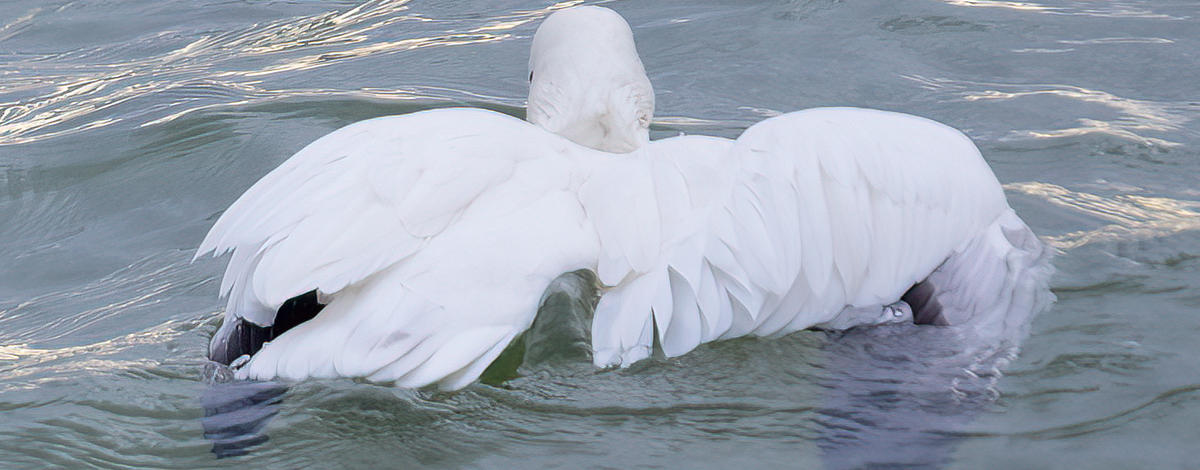Southwest Idaho is currently experiencing a waterfowl die-off that is primarily affecting light geese in Parma and surrounding areas, including the Lake Lowell Unit of Deer Flat National Wildlife Refuge. Staff at Fish and Game’s Wildlife Health Lab believe that a recent outbreak of avian cholera is responsible for this die-off. The persistence of highly pathogenic avian influenza (HPAI) infections in migratory bird populations is also contributing to some waterfowl mortalities in the area, although it is unclear if HPAI also contributed to this specific event.
“We suspect this mortality event is related to avian cholera, a bacterial infection. We are awaiting confirmation via diagnostic testing, but field investigations have found some birds with white and yellow spotted livers and lungs, which are indicative of avian cholera,” said Stacey Dauwalter, Fish and Game’s Wildlife Health Program Coordinator. “We know HPAI is still being found in migrating birds, as ducks are being tested at Wildlife Management Areas across the state in a coordinated effort with USDA–Wildlife Services, and that could be a factor as well.”
According to Migratory Game Bird Coordinator Jeff Knetter, mortality events like this are currently widespread.
“Groups of dead light geese – which include blue, snow, Ross’s geese – have been discovered in Arkansas, the Dakotas, Kansas, Oregon, and Washington,” Knetter said.
Idaho Fish and Game staff have picked up more than 350 dead snow geese and a handful of ducks off private land in the Notus/Parma area since last week and buried them on the Fort Boise Wildlife Management Area to prevent or slow further potential spread of avian cholera. Another 150 were recently picked up by city officials in nearby Nyssa, Oregon. Numerous reports of dead or sick waterfowl were reported to the Southwest Regional Office, the Wildlife Health Lab, and local conservation officers over the Thanksgiving holiday and continued over the weekend.
Larger-than-usual snow goose flocks recently dropped in
An estimated 50,000 snow geese were in Parma and surrounding areas last week, which is unusual for this time of year. Typically, peak snow goose migration in the region occurs in the late winter or early spring, when birds are on their return migration north. While unfortunate and somewhat unusual for this time of year in Southwest Idaho, several hundred of these 50,000 light geese dying in a mortality event does not present any population level concerns.
According to staff at the Fort Boise WMA, most of the light geese have moved on from the areas, so officials are hopeful that the number of sick or dead birds on the landscape should diminish as well.
“We know folks are seeing sick and dead birds on the landscape and want the public to know what is likely causing this,” said Southwest Regional Supervisor Josh Royse. “While avian cholera outbreaks happen almost annually in this area in the late winter or early spring, this year is somewhat unique both with the timing of large numbers of snow geese migrating into Southwest Idaho, as well as the continued presence of HPAI and associated mortalities in migratory populations.”
What is avian cholera?
Avian cholera is the result of infection caused by the bacterium Pasteurella multocida, and by itself can cause large mortality events — such as in 2017, when an outbreak in the Parma area resulted in the death of around 4,000 birds. Avian cholera is very common in white geese, and mortality events occur annually.
The bacterium kills swiftly – typically within 48 hours, which is roughly the same timeframe as HPAI – and is released into the environment by dead or dying birds, or by birds carrying the disease. Tight waterfowl concentrations can enhance disease transmission among healthy birds, and cold spells that cause smaller bodies of water to freeze can often concentrate birds in areas where water remains open. When more ponds, reservoirs and lakes thaw and waterfowl disperse, cholera outbreaks tend to diminish and eventually end.
What about HPAI?
While avian cholera is not considered a human health risk, the presence of HPAI still requires people to use proper handling techniques and protection when picking up carcasses. While uncommon, it is possible for humans to become infected with avian influenzas. Symptoms may include conjunctivitis, fever, lethargy, aches, coughing, or diarrhea. Being in direct contact with domestic birds is the highest risk activity. When USDA guidelines for cooking are followed, HPAI is not a foodborne illness.
HPAI is carried by waterfowl (geese and ducks) during migration. Idaho is within the Pacific Flyway. Domestic birds and poultry are very susceptible to morbidity and mortality once infected. HPAI is transmitted between birds through close contact (mucous), fecal matter, and sometimes as an aerosol. It is often carried on objects such as tools, vehicles, clothes, and boots, which can transfer the virus from one location to another.
What you should do if you find sick or dead waterfowl
Unfortunately, with both HPAI and avian cholera, morbidity and mortality can be high in infected birds, and there is no treatment for birds that show clinical symptoms. Given risk of transmission to other birds, including domestic flocks and other species, most rehabilitation centers in Southwest Idaho are not taking migratory waterfowl at their facilities at this time.
While Fish and Game will humanely euthanize sick birds brought into the Southwest Region Office, regional staff are discouraging people from transporting sick birds without using proper personal protective equipment and taking appropriate precautions.
If people see multiple dead birds, they are asked to call and report the location to Fish and Game’s Nampa Regional Office at (208) 465-8465. Depending upon the number of birds, if a caller has access to appropriate PPE and is comfortable doing so, Fish and Game staff may ask the caller if they are willing to pick up and dispose of the carcasses themselves.

